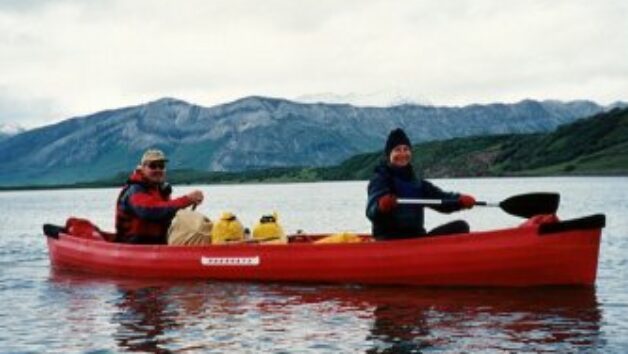Riding the Flood in a PakCanoe (2000)
Dear Sirs,
There are many rivers in Alaska that are hardly known to paddlers, and once in a while we decide to run one of them and try something new. Last year we picked the upper part of the John River in the Brooks Range. Pretty much everybody told us that the first 20 miles are not canoeable, but we wanted to find out for ourselves.
The John is pretty easy, if you start halfway down, but we took a scheduled flight into Anaktuvuk Pass (a native village), where the John basically starts. For this excursion we took one of your PakCanoes and put in pretty much right at the airport. Unfortunately, the river is only about 20 ft wide and pretty shallow. But we started down the river full of optimism with gear and food for two weeks as well as a dog named Tigger that is half wolf and has slept in canoes since she was a puppy.
The optimism was gone by the next afternoon as we were still dragging the canoe in shallow water. Our map indicated that we had come about 13 miles and our 17-ft PakCanoe had already taken more abuse than we could reasonably expect it to put up with. And there was no sign that the shallow water would end anytime soon. My partner pointed to the trickle around his boots that was supposed to be the John River and said with a wry grin: “Not canoeable”. For the rest of the day the term “not canoeable” became one of those jokes that are only funny when you are under stress. We could hear the keel scraping over the gravel bottom as we mostly dragged and sometimes paddled 50 yards or so. We knew that our canoe was never built for this kind of abuse.
Towards evening a thunderstorm moved in, and the echo from the thunder rolled between the mountains for a long time before the rain started. We made camp and watched the rain move into the mountains to the north, where we could still see lightening and black clouds until midnight. A quick check of our boat surprisingly showed no serious damage. While we were enjoying a cup of tea by the campfire we noticed that the clear water in the river was turning silty. Two hours later the water was up two feet and we had to move our camp to higher ground. Branches were drifting down the river, pushed by the current that was clearly getting stronger. With a thoughtful look on his face my partner said: “Looks canoeable”. There would be no need to drag the boat the next day. After the thunderstorm in the mountains there would be enough water to float the boat.
By the next morning the river was over its banks and looked like a brown mass carrying whole trees along. The clear and shallow stream of the previous day had been transformed into a raging flood flowing through the brush along the banks. We decided to run the river instead of waiting and may be having to drag the boat again. It was a hell of a ride.
The river was very fast with impossible curves, high rock walls and boulders all over the place. Starting early in the morning, we ran the flash flood all day. It was pretty hairy…, I don’t know…but we stopped every mile, just to bring our adrenaline level back down a bit. At some spots the river was not even 20 feet wide with the occasional sweepers and such. A hardshell canoe would never have survived, but your boats have a snakelike ability to glide over rocks and ride standing waves.
Branches on trees that were stuck in the river broke against the side of the boat. Tigger remembered her training and stayed well down in the boat – while giving us blameful looks. Several times we were able to get untangled from floating branches by making a 360 degree turn even when the stream was hardly wide enough for such a maneuver. Our boat was without a doubt in an environment that no canoe is intended for, and I suspect that the manufacturer would caution us against everything we did that day.
We made it to Hunt Fork where the river gets easier…and never dumped. Hereby I must declare that the John River above Hunt Fork is not canoeable. A kayak might make it – if you wait for the right storm, but no canoe. We were simply lucky and had a good boat. The 17-ft PakCanoe is now on the Alatna River near the Arrigetch Peaks on a 4-week trip. The only damage to the canoe from our John River adventure was two punctures in the bottom that we got running over some rocks that we simply could not avoid at 15 mph. The patches we applied work just fine and are still there 1000 river miles later – and the canoe still looks good.
As I assembled the PakCanoe for the first time and got in, I honestly did not perceive how rugged a piece of equipment it is. In whitewater it develops a life of its own that I really value after my experience on the John. But I will never canoe the upper part of the John River again. It is not canoeable. However, there is the upper part of the Killik River, and nobody seems to really know if it is canoeable. Maybe next year….
Thank you very much for a well designed and rugged folding canoe. We will without a doubt add to our fleet of 17-ft PakCanoes in the future.
Sincerely,
Peter Kamper
Alaska Expedition Service
